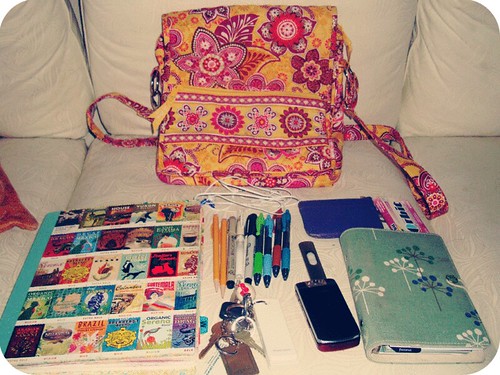
I am SUCH a bag collector; I have over a hundred, and can't go three months without buying a new one. I don't know what it is...I feel like a bag is an extention of my personality, and I usually change them based on how I'm feeling/where I'm going. The nice thing about this is that they're all in really nice condition because I never carry them longer than a month at a time!
Here's my current bag; I LOVE IT. Click on the image to go to flickr and see the notes on each of the items. And then, come back over here to read about how I select a bag for my on-the-go journaling adventures!
One of the greatest ways to truly capture your life in your journal is to carry it with you everywhere, searching for those snippets of time when you can take a moment to record your world. But taking your journal with you, whether on a specific journaling journey or in search of spontaneous, elusive moments, can be a bit tricky, especially if it’s not a tiny Moleskine affair.
Tossing a 5“x7” or larger journal into your purse can be...tricky. Here are some pointers on how you can find the perfect bag to either replace your purse or supplement it when you’re off on an adventure.
SIZE
Obviously, it needs to be able to fit your journal. But what more than that?
Along with deciding to carry your journal, you need to take a look at what supplies you’ll be carrying with you. One of the mistakes people make is carrying TOO much; that can overburden you and your bag, causing you to re-consider carrying anything at all.
You don’t need many supplies. Realistically, most of your on-the-go journaling will be writing or doodling on pages you’ve already painted and collaged, so papers, scissors, and other tools aren’t really necessary. I do recommend carrying double-sided tape for those slips of epherma you gather along the way, but other than that, pens and a pencil are fine.
Personally, I carry the following in addition to my journal:
- 4 G2 gel pens in assorted cool colors
- 1 white gel pen
- 1 pencil
- 1 Sakura micron pen (.05)
- 1 ultra-fine black Sharpie
I find that these serve my needs while out and about very well, and if I do end up drawing something that needs more, I’ll color/add to it at home.
STYLE
Are you a messenger bag type person, a tote person, or a backpack person?
You can find any style of bag in the size you need if you really look around. The bag needs to be comfortable and practical, with the organization you need to carry your supplies. If you’ll be replacing your purse, make sure you can fit your daily items in the bag in addition to your journal and supplies. One with a great variety of pockets is good, but you want the bag to reflect your style and personality as well.
You can choose to grab a canvas bag to embellish and journal on (here’s some inspiration for journaled bags), completing the feel & look of your new accessory.
ORGANIZATION
If your bag doesn’t have a ton of pockets, you’ll need something to keep your stuff in! WIll you use a pencil bag, tin, or school box? Again, this depends on what you choose to carry.
Perhaps you can use a small bag for daily use and set aside a larger box or tin for when you’re going out specifically to journal; this can double as studio storage for your favorite pens and markers when not in your bag. Check out the storage aisle of your favorite art supply or hobby shop for plastic boxes perfect for organizing pens, crayons, markers, and whatever else you love to use!
I can tell you from experience that organizing supplies like crayons or colored pencils in a plastic box by color is really helpful when out working in your journal. My favorite is the ArtBin Solutions Series. These boxes are around the same size as a nice school box, but easily dividable for customization. I use the 3 to 13 size one for my watercolor crayons, giving each section a color range to store. A larger holds my Portfolio Oil Pastels. This allows me to just grab a bin and go, and the layout makes it easy to work as I can see everything laid out in front of me -- I prefer this to a pencil pouch, since things can get “buried” in the bottom of those pouches.
If you can find the right bag, supplies, and organizational tools, carrying your journal will become second nature, and soon, you won’t be able to leave home without it! Now, we just need to get you working in it out in public...
love, kira

